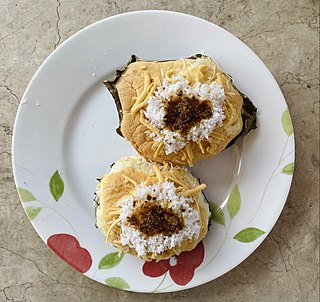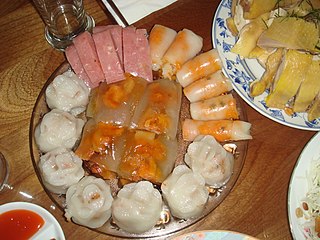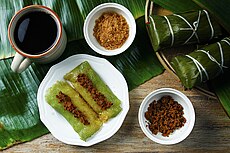
Glutinous rice is a type of rice grown mainly in Southeast and East Asia, and the northeastern regions of South Asia, which has opaque grains, very low amylose content, and is especially sticky when cooked. It is widely consumed across Asia.

Coconut jam, also known as kaya jam or simply kaya, is a sweet spread made from a base of coconut milk, eggs, sugar and sometimes pandan leaves as a flavouring. It is popular throughout Southeast Asia.

Kuih are bite-sized snack or dessert foods commonly found in Southeast Asia and China. It is a fairly broad term which may include items that would be called cakes, cookies, dumplings, pudding, biscuits, or pastries in English and are usually made from rice or glutinous rice. In China, where the term originates from, kueh or koé (粿) in the Min Nan languages refers to snacks which are typically made from rice but can occasionally be made from other grains such as wheat. The term kuih is widely used in Malaysia, Brunei, and Singapore, kueh is used in Singapore and Indonesia, kue is used in Indonesia only, all three refer to sweet or savoury desserts.

Filipino cuisine is composed of the cuisines of more than a hundred distinct ethnolinguistic groups found throughout the Philippine archipelago. A majority of mainstream Filipino dishes that compose Filipino cuisine are from the food traditions of various ethnolinguistic groups and tribes of the archipelago, including the Ilocano, Pangasinan, Kapampangan, Tagalog, Bicolano, Visayan, Chavacano, and Maranao ethnolinguistic groups. The dishes associated with these groups evolved over the centuries from a largely indigenous base shared with maritime Southeast Asia with varied influences from Chinese, Spanish, and American cuisines, in line with the major waves of influence that had enriched the cultures of the archipelago, and adapted using indigenous ingredients to meet local preferences.

Bibingka commonly refers to a type of baked rice cake from the Philippines that is traditionally cooked in a terracotta oven lined with banana leaves and is usually eaten for breakfast or as merienda especially during the Christmas season. It is also known as bingka in the Visayas and Mindanao islands.

A rice cake may be any kind of food item made from rice that has been shaped, condensed, or otherwise combined into a single object. A wide variety of rice cakes exist in many different cultures in which rice is eaten. Common variations include cakes made with rice flour, those made from ground rice, and those made from whole grains of rice compressed together or combined with some other binding substance.

Kue is an Indonesian bite-sized snack or dessert food. Kue is a fairly broad term in Indonesian to describe a wide variety of snacks including cakes, cookies, fritters, pies, scones, and patisserie. Kue are made from a variety of ingredients in various forms; some are steamed, fried or baked. They are popular snacks in Indonesia, which has the largest variety of kue. Because of the countries' historical colonial ties, Koeé (kue) is also popular in the Netherlands.

In Vietnamese, the term bánh translates loosely as "cake" or "bread", but refers to a wide variety of prepared foods that can easily be eaten by hands or chopsticks. With the addition of qualifying adjectives, bánh refers to a wide variety of sweet or savory, distinct cakes, buns, pastries, sandwiches, and other food items, which may be cooked by steaming, baking, frying, deep-frying, or boiling. Foods made from wheat flour or rice flour are generally called bánh, but the term may also refer to certain varieties of noodle and fish cake dishes, such as bánh canh and bánh hỏi.

Kalamay is a sticky sweet delicacy that is popular in many regions of the Philippines. It is made of coconut milk, brown sugar, and ground glutinous rice. It can also be flavored with margarine, peanut butter, or vanilla. Kalamay can be eaten alone; but is usually used as a sweetener for a number of Filipino desserts and beverages. It is related to the Chamorro dessert called Kalamai.

Puto is a Filipino steamed rice cake, traditionally made from slightly fermented rice dough (galapong). It is eaten as is or as an accompaniment to a number of savoury dishes. Puto is also an umbrella term for various kinds of indigenous steamed cakes, including those made without rice. It is a sub-type of kakanin.

Javanese cuisine is the cuisine of Javanese people, a major ethnic group in Indonesia, more precisely the province of Central Java, Yogyakarta and East Java.

A great variety of cassava-based dishes are consumed in the regions where cassava is cultivated, and the ingredient is included many national or ethnic specialities.

Wajik or wajid, also known as pulut manis, is a traditional glutinous sweet made with rice, sugar and coconut milk. It is an Indonesian kue, and a kuih of Brunei, Singapore and Malaysia.

Pichi-pichi, also spelled pitsi-pitsi, is a Filipino dessert made from steamed cassava flour balls mixed with sugar and lye. It is also commonly flavored with pandan leaves. It is served rolled in freshly grated coconut, cheese, or latik before serving.

Pusô or tamu, sometimes known in Philippine English as "hanging rice", is a Filipino rice cake made by boiling rice in a woven pouch of palm leaves. It is most commonly found in octahedral, diamond, or rectangular shapes, but it can also come in various other intricately woven complex forms. It is known under many different names throughout the Philippines with numerous variations, but it is usually associated with the street food cultures of the Visayan and Moro peoples.

In Filipino cuisine, moron is a rice cake similar to suman. It is a native delicacy of the Waray people in the Eastern Visayas region of the Philippines, particularly in the area around Tacloban City in the province of Leyte and in Eastern Samar province. Other parts of the Philippines have their versions of it, however. In fact, the moron was adopted as one of Mambajao, Camiguin's locally produced products.

Cassava cake is a traditional Filipino moist cake made from grated cassava, coconut milk, and condensed milk with a custard layer on top. It is a very popular dish in the Philippines, where it is commonly eaten for merienda. It is also served during gatherings and special occasions.
Sayongsong is a traditional Filipino steamed rice cake from Surigao del Norte and other areas of the Caraga Region of northeastern Mindanao, as well as the southeastern Visayas where it is known as sarungsong or alisuso. It is distinctively served in cone-shaped banana leaves. Sayongsong is a type of puto.

Nilupak is a class of traditional Filipino delicacies made from mashed or pounded starchy foods mixed with coconut milk and sugar. They are molded into various shapes and traditionally served on banana leaves with toppings of grated young coconut (buko), various nuts, cheese, butter, or margarine. It is also known as nilusak, linusak, niyubak, linupak, or lubi-lubi, among many other names, in the various languages of the Philippines. It is also known as minukmok in Quezon.























